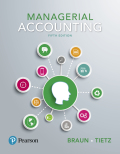
Determine ending inventory balances (Learning Objectives 5)
Unique Displays designs and manufactures displays used in mobile devices. Serious flooding throughout the region affected Unique Displays’ facilities. Inventory was completely ruined, and the company’s computer system, including all accounting records, was destroyed.
Before the disaster recovery specialists clean the buildings, Louise Ditchey, the company controller, is anxious to salvage whatever records she can to support an insurance claim for the destroyed inventory. She is standing in what is left of the Accounting Department with Trent Parker, the cost accountant.
“I didn’t know mud could smell so bad,” Trent says. “What should I be looking for?”
“Don’t worry about beginning inventory numbers.” responds Louise. “We’ll get them from last year’s annual report. We need first-quarter cost data.”
“I was working on the first-quarter results just before the storm hit,” Trent says. “Look, my report’s still in my desk drawer.
But all I can make out is that for the first quarter, direct material purchases were $533,000 and that direct labor, manufacturing overhead (other than indirect materials), and total
“Great,” says Louise, “I remember that sales for the period were approximately $1.8 million. Given our gross profit of 30%, that’s all you should need.”
Trent is not sure about that but decides to see what he can do with this information. The beginning inventory numbers are as follows:
- Raw materials, $75,000
- Work in process, $226,000
- Finished goods, $213,000
He remembers several schedules he learned in college that may help him get started.
Requirement
Use exhibits in the chapter to determine the ending inventories of raw materials, work in process, and finished goods. Assume that Raw Materials Inventory contains only direct materials.
Want to see the full answer?
Check out a sample textbook solution
Chapter 2 Solutions
EBK MANAGERIAL ACCOUNTING
- Determine the term being defined or described by the following statement: Evaluation of how income will change based on an alternative course of action. a. Differential analysis b. Opportunity cost c. Product cost distortion d. Sunk cost e. Theory of constraintsarrow_forwardAccount Que.arrow_forwardWhat is Jordan ROE? General accountingarrow_forward
- Business Its Legal Ethical & Global EnvironmentAccountingISBN:9781305224414Author:JENNINGSPublisher:Cengage
 College Accounting (Book Only): A Career ApproachAccountingISBN:9781337280570Author:Scott, Cathy J.Publisher:South-Western College Pub
College Accounting (Book Only): A Career ApproachAccountingISBN:9781337280570Author:Scott, Cathy J.Publisher:South-Western College Pub - Business/Professional Ethics Directors/Executives...AccountingISBN:9781337485913Author:BROOKSPublisher:Cengage





